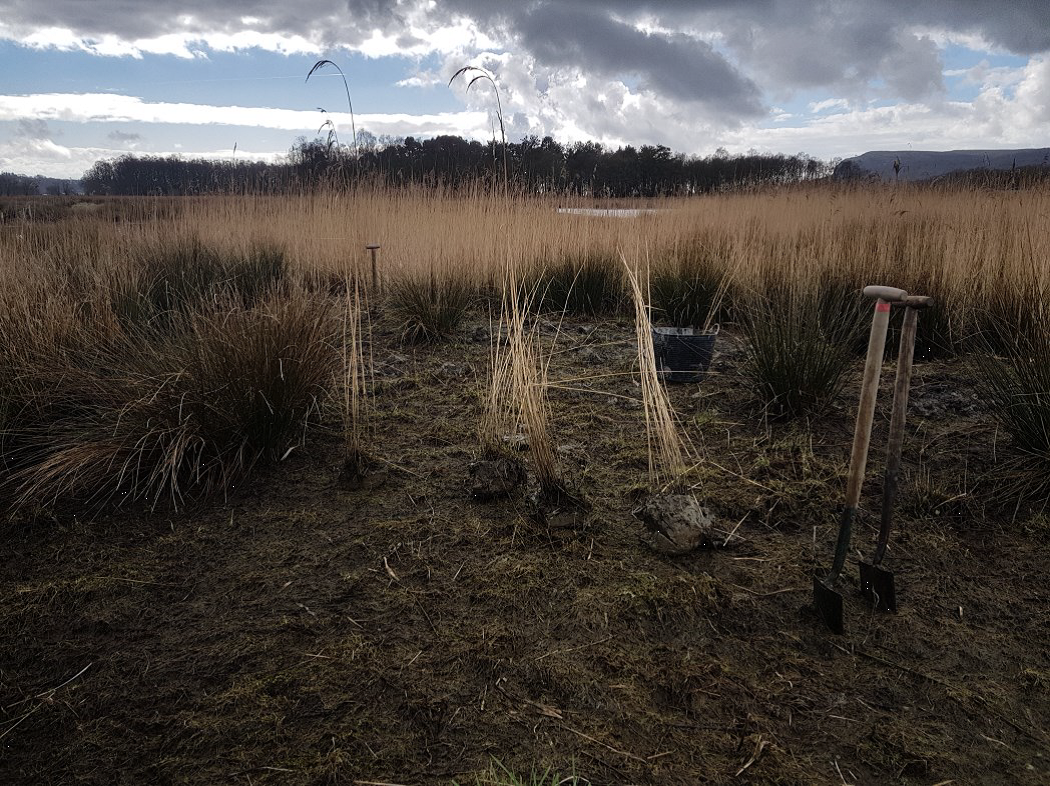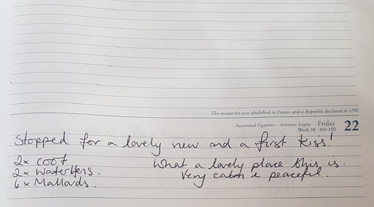National Trust - Wetlands Updates2018 Wetland update. Jan—March
Over the winter period the wetland has held a flock of Wigeon and Teal. Around 300 of each have been using the site most days from December to the end of February. Both are now starting to disperse.
Other duck species include up to 6 Tufted Duck and 5 Gadwall (4 male, 1 female). Gadwall are a dabbling duck that like marshy wetlands. In March duck species start displaying with the males seen fighting off other males in order to find a female. I saw the Gadwall displaying (22nd March) which could indicate a breeding attempt which would be good. |
The photos above show the intruding displaying male getting chased away by the male with the female. The conspicuous white wing panel is the key to identifying this other-wise rather grey duck. They are often hiding in the reeds so then there quack is the only way they give away there presence, this being a deeper and shorter tone than of the mallards.
Another secretive species is the Water Rail. These are more often heard than seen with there distinctive high pitched squealing call becoming evocative of an early morning down on the wetland.
I managed a glimpse of one from the hide.
Another secretive species is the Water Rail. These are more often heard than seen with there distinctive high pitched squealing call becoming evocative of an early morning down on the wetland.
I managed a glimpse of one from the hide.
The thin red bill is distinctive to its often mistaken identity of the Moorhen. Also as pointed out above the tail feathers are different. Side by side big white flashes of the Moorhen and slight triangle shaped of the rail help separate them even on the briefest of views.
Single Pied Wagtails are common place in most gardens and towns but to see 120 of them sitting in the oak tree dropping to drink in the wet flush next to the hide was pretty cool.
Single Pied Wagtails are common place in most gardens and towns but to see 120 of them sitting in the oak tree dropping to drink in the wet flush next to the hide was pretty cool.
Little Grebes once again are putting on a good show fishing in front of the hide. There characteristic trilling calls heard from early March were a sign to me that Spring has arrived. 12 individuals have been counted on site.
Daily counts of 12 Little Egret are a sign that this species clearly is on the increase with fields and ditches nearby also holding additional birds. Most leave for roost in the direction of Leighton Moss with a handful flying north west to a site further up the Lyth.
A female Hen Harrier was seen on a couple of occasions earlier in the year. This individual was later seen going through Leighton Moss. A female Marsh Harrier was also seen. A Kingfisher can still be seen perching from the hide with dawn and dusk best to see it.
3 Stonechat have wintered on site with one showing occasionally from the hide perching on the kingfisher posts.
The first Swallow was seen on 7th April and 12 Sand Martin on the 8th.
Other sightings
8 Canada geese
12 Greylag geese (with 1 Pink footed goose with them)
Daily Sparrowhawk and Kestrel
Any day now Sedge Warblers will be arriving. Grasshopper warblers also will start reeling shortly after.
Other news
During March reed planting was carried out on the southern section with the fence being moved further out thus creating a larger area to plant in. The volunteer team spent the day digging clumps of reed and re planting around the edges of the channels.
Daily counts of 12 Little Egret are a sign that this species clearly is on the increase with fields and ditches nearby also holding additional birds. Most leave for roost in the direction of Leighton Moss with a handful flying north west to a site further up the Lyth.
A female Hen Harrier was seen on a couple of occasions earlier in the year. This individual was later seen going through Leighton Moss. A female Marsh Harrier was also seen. A Kingfisher can still be seen perching from the hide with dawn and dusk best to see it.
3 Stonechat have wintered on site with one showing occasionally from the hide perching on the kingfisher posts.
The first Swallow was seen on 7th April and 12 Sand Martin on the 8th.
Other sightings
8 Canada geese
12 Greylag geese (with 1 Pink footed goose with them)
Daily Sparrowhawk and Kestrel
Any day now Sedge Warblers will be arriving. Grasshopper warblers also will start reeling shortly after.
Other news
During March reed planting was carried out on the southern section with the fence being moved further out thus creating a larger area to plant in. The volunteer team spent the day digging clumps of reed and re planting around the edges of the channels.
Find out more about other local activities and regular events
Wetland Bird List
|
Little Grebe (B)
Cormorant Bittern (W) Heron Little Egret Mute Swan (B) Whooper Swan (W) Pink Footed Goose (W) Greylag Goose (B) Canada Goose (B) Shelduck Wigeon (W) American Wigeon (Ra) Gadwall Teal Mallard (B) Garganey (S) Pintail (W) Shoveler Pochard (W) Tufted Duck (B) Scaup (W,S) Goldeneye (W) Goosander Marsh Harrier Hen Harrier (W) Goshawk Sparrowhawk Buzzard Red Kite Opsrey Kestrel Peregrine Pheasant (B) Water Rail Moorhen (B) Coot (B) Crane (Ra) Oystercatcher (B) Little Ringed Plover (S) Ringed Plover (S) Lapwing (B) Dunlin (S,W) |
Ruff (S,W)
Jack Snipe (W) Snipe Woodcock Black Tailed Godwit (S,W) Curlew Whimbrel (S) Redshank Greenshank (S) Green Sandpiper (S) Common Sandpiper (S) Black Headed Gull Common Gull Lesser Black Backed Gull Herring Gull Great Black Backed Gull Stock Dove Wood Pigeon (B) Collared Dove Cuckoo (S) Barn Owl Tawny Owl Swift (S) Kingfisher Green Woodpecker Great Spotted Woodpecker Skylark Sand Martin (S) Swallow (S) House Martin (S) Tree Pipit (S) Meadow Pipit Yellow Wagtail (S) Grey Wagtail White Wagtail Pied Wagtail Wren (B) Dunnock Robin (B) Whinchat (S) Stonechat (W) Blackbird (B) |
Fieldfare (W)
Song Thrush (B) Redwing (W) Mistle Thrush Grasshopper Warbler (S) Sedge Warbler (S) Reed Warbler (S) Blackcap (S) Whitethroat (S) Chiffchaff (S) Willow Warbler (S) Goldcrest Spotted Flycatcher (S) Long Tailed Tit Marsh Tit Coal Tit Great tit (B) Blue Tit (B) Nuthatch Treecreeper Jay Magpie Jackdaw Rook Carrion Crow (B) Raven Starling House Sparrow Chaffinch (B) Greenfinch Goldfinch Siskin Linnet Redpoll Crossbill Bullfinch Hawfinch Reed Bunting (B) |
Codes are as follows.
B – Breeding S – Spring/Summer – seen on passage/breed W – Winter – Winter visitor Ra – Rare Should appear/most wanted
Great crested grebe Spoonbill Cattle Egret Great white egret Smew Hobby Avocet Golden Plover Wood Sandpiper Med Gull Common Tern Short Eared Owl Redstart Wheatear Tree Sparrow |













